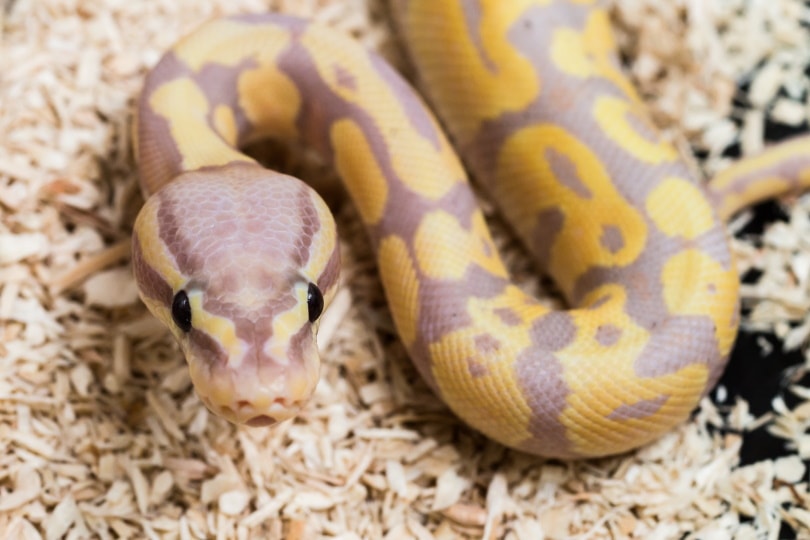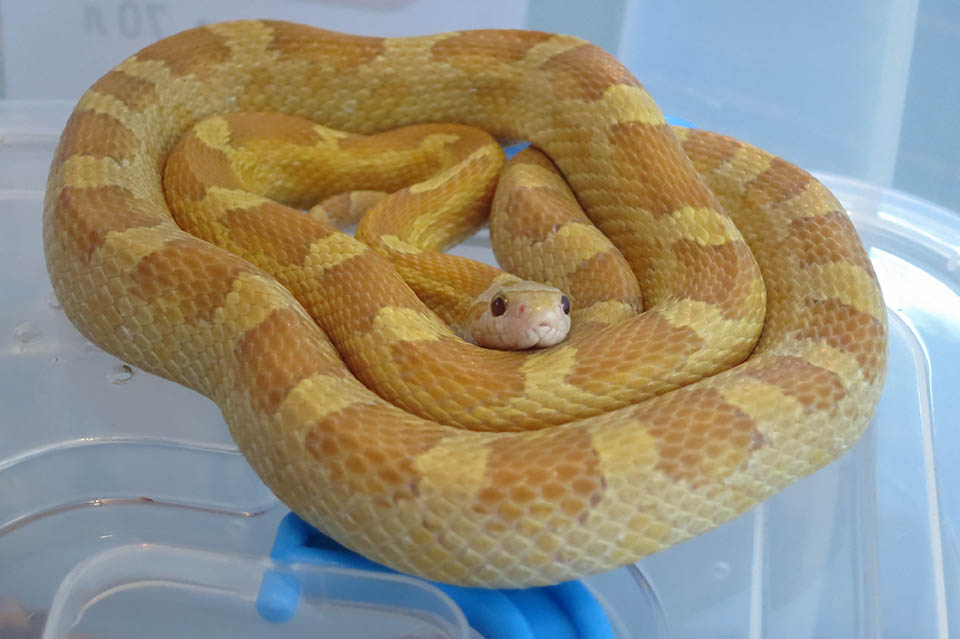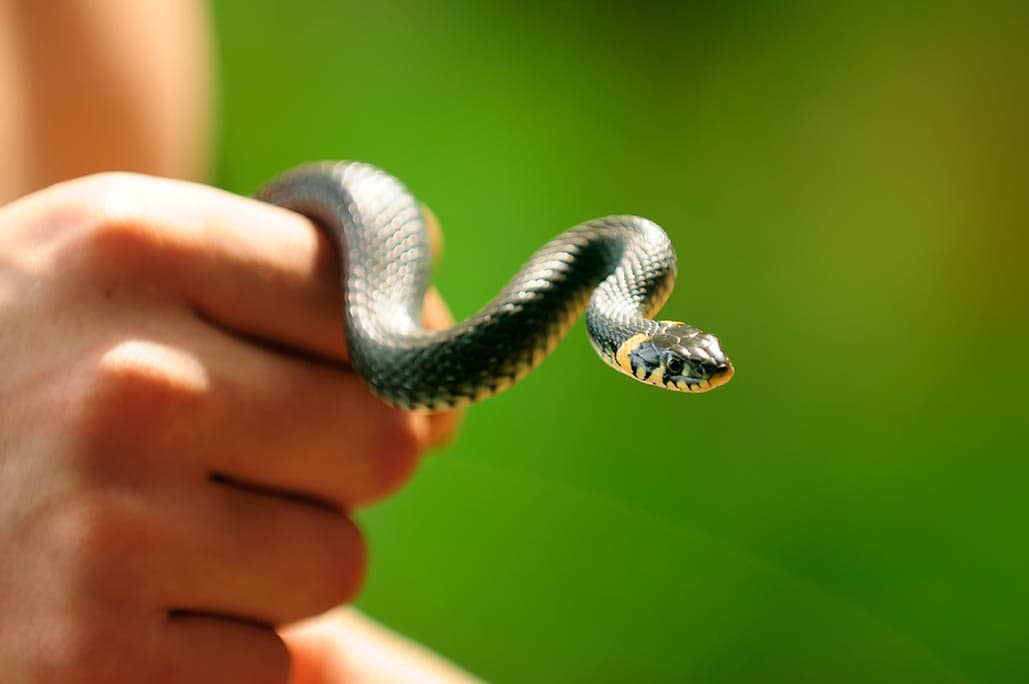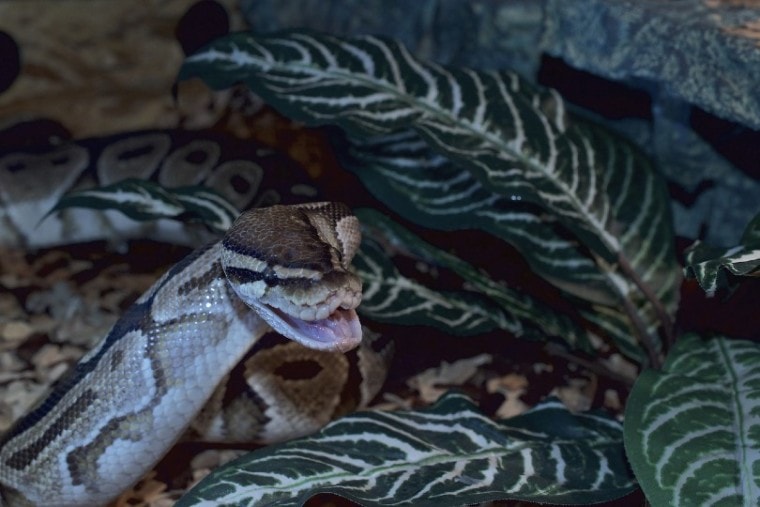
The Axanthic Ball Python is a color morph of the Ball Python, one of the most popular pet snakes, as they are relatively easy to care for. The Axanthic Ball Python acts and looks just like the Ball Python except for their color—which is in variations of white, black, and gray.
The term Axanthic actually means the snake has a recessive mutation that only produces gray, brown, and black colors—they lack yellow and red pigments. They have all of the standard patterns of a Ball Python, but Axanthics are color mutations and are fairly rare.
When researching the Axanthic Ball Python, you will inevitably come across the names of the more popular lines of this morph—VPI, Jolliff, Snake Keeper, and Marcus Jane. These are breeders of the Axanthic morph, and they contributed to four bloodlines of this snake.
These interesting and beautiful snakes make wonderful pets, so we’ll have a look at how to care for one before you bring one home with you.
Quick Facts about the Axanthic Ball Python Morph
| Species Name: | Python regius |
| Family: | Pythonidae |
| Care Level: | Easy |
| Color Form: | Black, white, and gray |
| Lifespan: | Up to 40 years |
| Adult Size: | 3–4.5 feet |
| Diet: | Frozen but thawed rats or mice |
| Minimum Tank Size: | 40+ gallons |
| Temperature & Humidity: | 75º–85° F with 90° F basking area and 60% humidity |

Do Axanthic Ball Python Morphs Make Good Pets?
Because the Axanthic Ball Python is a Ball Python in every way except in color, it does make an excellent pet. Particularly for any beginners wanting to try out their first snake.
They are also quite low-maintenance. They don’t typically need grooming, exercising, or lots of attention. Vet bills are also pretty low, as is the cost of feeding them.
Appearance
As you’ve already seen, the Axanthic morph is white, black, and grey. However, this primarily occurs when they are young. When they become adults, they start to “brown out.” This means that the adults begin to turn a brownish color.

How to Take Care of an Axanthic Ball Python Morph
Habitat, Tank Conditions & Setup
Tank
If you have a young Axanthic, a 15-20 gallon vivarium is recommended, and you’ll need at least a 40-gallon tank for a full-grown adult. You’ll want to provide your snake with two hides (a box or place to hide), one in the cooler area and one where the snake will bask. You should also provide your snake with a water dish, which should only be filled with bottled water (not distilled or tap). You need to spot clean the vivarium every day by removing dirty or wet substrate. Give the tank a deep clean every one or two months.
Lighting
They don’t need special lighting but don’t place the terrarium next to a window since you can’t control the temperature. Just ensure day/night cycles are followed as much as possible.
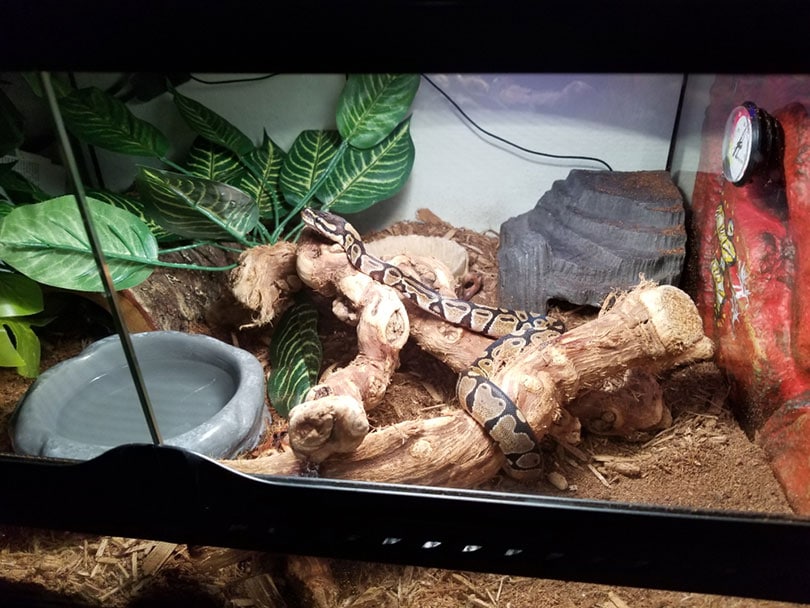
Heating (Temperature & Humidity)
You’ll need a basking lamp that should heat only about one-third of your snake’s vivarium. Snakes need a cool and warm area in their enclosures. Many enclosures come with heating tape attached to the bottom.
The general temperature should be around 82° F with the cooler side at about 75°–80° F, and the warm side at 88°–92°F (the temperature should never be below 75° F or higher than 95° F) and humidity should be 50-60%.
Substrate
The bedding needs to retain moisture to keep the humidity levels optimum. There’s a number of substrates to choose from, but cypress mulch does a great job at retaining moisture but is also mold resistant. Others to consider are reptile bark, aspen shavings, and coconut husks.
| Tank Recommendations | |
| Tank Type: | 40-gallon vivarium |
| Lighting: | Mimic day/night cycles |
| Heating: | Heating pad/tape on bottom of enclosure |
| Best Substrate: | Cypress mulch |

Feeding Your Axanthic Ball Python Morph
An adult Axanthic Ball Python only needs to be fed a medium-sized mouse or rat once every 1 to 2 weeks.
Juvenile snakes should be fed small rodents once a week. As your Python grows, the prey should increase in size as well.
It’s also essential that you only feed frozen rodents that you’ve thawed beforehand to your snake.
Don’t ever feed your Axanthic morph live prey as the rodent will defend itself and could injure your snake.
| Diet Summary | |
| Fruits | 0% of diet |
| Insects | 0% of diet |
| Meat | 100% of diet – small/medium-sized rodents |
| Supplements Required | N/A |
Keeping Your Axanthic Ball Python Morph Healthy
Common Health Issues
Axanthic Ball Pythons are quite robust snakes, and they don’t tend to be prone to many serious health issues. However, some problems that are typical for these snakes are:
Respiratory Infections
Mites
Scale Rot
Incomplete Shedding
Just like how it sounds. While shedding, the skin might stay attached to the snake in some spots. The most serious area is when the skin remains on the eye caps, which can lead to infections.
If your snake exhibits any worrying symptoms, do consult with your vet.

Lifespan
Axanthic Ball Pythons, on average, live until they are 30 to 40 years old, but some have been known to even live up to 60! As long as you take good care of your Axanthic morph, it should live quite a long time just as long as you take care of its health, diet, and vivarium.
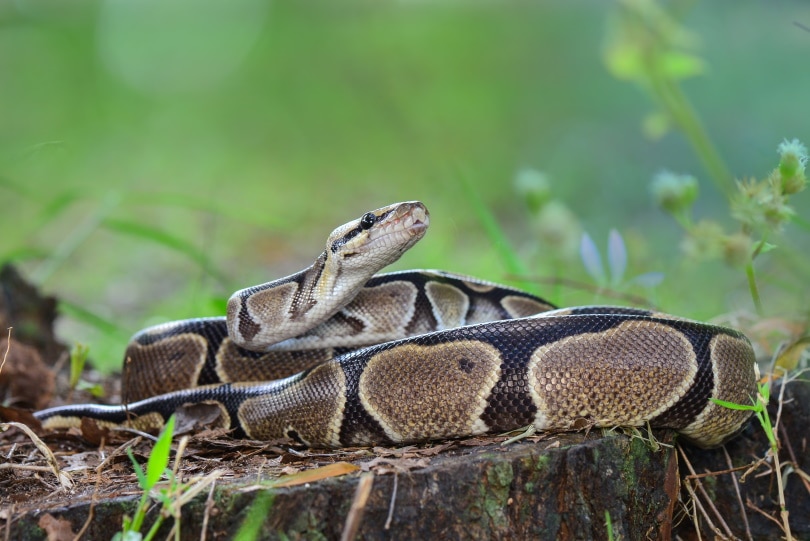
Breeding
In order to get the Axanthic morph coloring, both parents must have recessive genes. They must be homozygous with recessive Axanthic morph genes. This will give you 100% Axanthic hatchlings.
The breeding season for the Ball Python goes from early November until mid-March. Breeding snakes includes creating a winter-type environment within the enclosure by dropping the temperature to the mid-70s overnight and high-80s during the day.
For the females, how much and how often you feed her should also be gradually decreased. The male needs to be older than 18 months, be at least 1½ pounds, and healthy.
When locking occurs, both of the tails will be wrapped tightly, and it can last from 4 hours to as long as 2 days.
Are Axanthic Ball Python Morphs Friendly? Our Handling Advice
Axanthic Ball Pythons are very calm and docile snakes, which is why they are so popular. Many of these snakes actually enjoy being handled and don’t become stressed out like other snakes. Just don’t handle your Axanthic Ball Python right after it’s eaten, or it might regurgitate it!
When you do pick up a Ball Python, start by washing your hands. Then gently touch your Axanthic on its back while it’s in the vivarium. Once it’s aware of your presence, put your hand under the midpart of your snake and gently lift it up while supporting its body weight. You can then enjoy your snake winding around your arms and body and just generally hanging out with you
Shedding & Brumation: What to Expect
Axanthic Ball Pythons typically shed their skin all in one piece every 4 to 6 weeks. You can provide it with a large bowl filled with water and fill its hide with moist moss to help your snake shed. Don’t handle your snake during the shed, and don’t help it shed by pulling on the skin.
Axanthic Ball Python Morphs do not hibernate during the winter season, but you might notice your snake not eating for a few weeks or months. This is normal. It can last from September until April, but when they sense warmer weather, they will come out of brumation.
How Much Do Axanthic Ball Python Morphs Cost?
Depending on the bloodline, the price for the Axanthic can range quite widely. Currently, the cost can range from $200 to $15,000. The price might be lower if it’s an adult that has started to turn brown, or much higher if it’s particularly unique in its color and pattern and is rare.
Care Guide Summary

Final Thoughts
The Axanthic Ball Python is a striking snake that would make a wonderful pet for any snake enthusiast. Make sure you do your research and read up on what your snake will need to thrive, and you’ll have a fascinating pet for many years to come!
See also:
- 50 Types of Ball Python Morphs & Colors (With Pictures)
- Bamboo Ball Python Morph: Facts, Appearance, Pictures, & Care Guide
Featured Image Credit: aixklusiv, Pixabay

